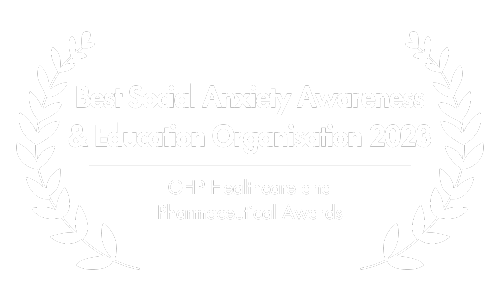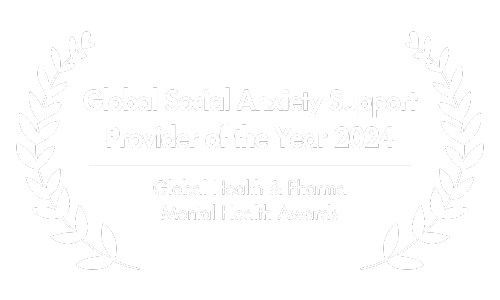Fear Flusher: How Beta-Blockers Ease Social Anxiety’s Physical Burden
This article features a suggestion for an online psychiatry service, where certified mental health experts can assess social anxiety, offer diagnoses, and prescribe medications if appropriate. By using this link, you may receive a significant discount on the service, and we will earn a commission.

Social anxiety, a common mental health challenge, affects countless individuals, making social interactions feel like a daunting feat.
The physical symptoms of social anxiety, such as rapid heart rate, trembling, and sweaty palms, can be distressing and hinder daily life experiences.
Fortunately, there are options available to help manage these physical manifestations and provide relief to those struggling with social anxiety.
One such option is the use of ß-blockers, a class of medication known for their ability to target the physical symptoms of anxiety (Lader, 1988).

Unlike traditional anxiety medications, ß-blockers do not directly influence the emotional or cognitive aspects of anxiety but focus solely on reducing the physiological responses triggered by anxiety-inducing situations (Kelly, 1980).
In this comprehensive guide, we will explore the practical benefits of ß-blockers for social anxiety, shedding light on how they can effectively prevent and reduce the physical symptoms that often accompany social phobia.
However, it is important to emphasize that the decision to explore medication, including ß-blockers, should always be made in consultation with a qualified mental health care professional.
They can assess individual needs, provide personalized recommendations, and ensure a safe and appropriate treatment approach.

Throughout this guide, we will provide insights into how ß-blockers work, their effectiveness in managing social anxiety’s physical symptoms, potential side effects, and essential considerations for using them as part of a comprehensive anxiety management strategy.
If you find yourself grappling with the physical grip of social anxiety and seeking practical ways to regain control of your life, this guide is here to offer guidance and support.
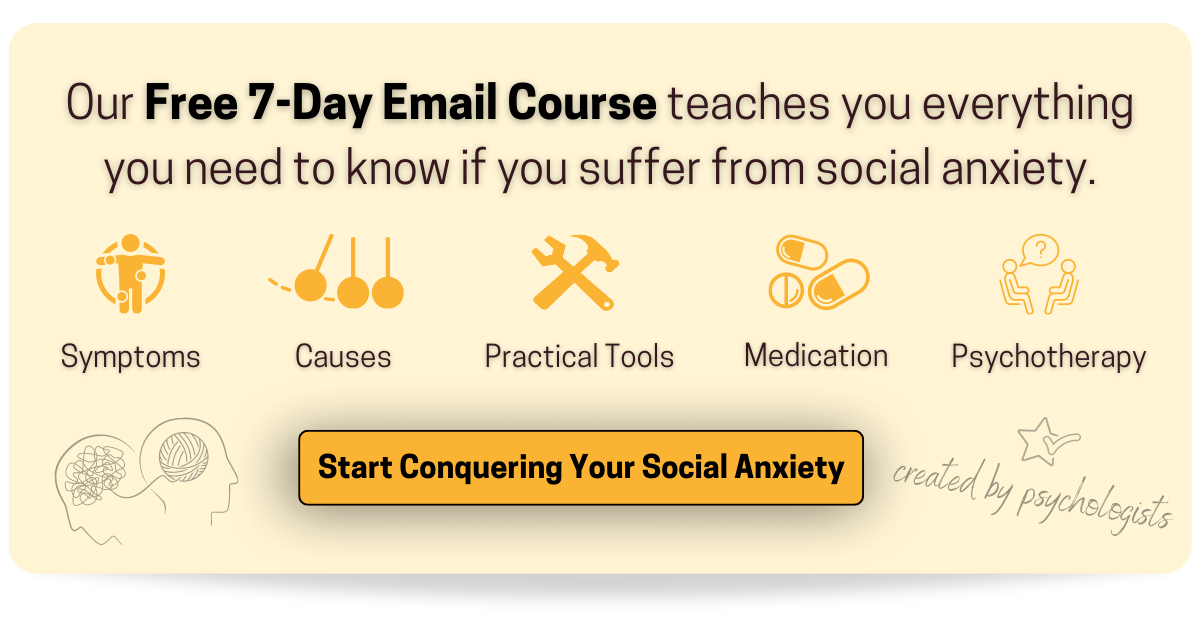
A. Exploring Medication Options for Social Anxiety
Overview of Medication Options for Social Anxiety
When struggling with the overwhelming grip of social anxiety, finding an effective treatment approach is key.
In addition to therapy and behavioral interventions, medication can play a valuable role in alleviating the challenges posed by social phobia (Williams et al., 2017).
Commonly considered as primary medications for addressing social anxiety are SSRIs (find our comprehensive article about them here) and SNRIs (explore our dedicated article about them here).
Additional medications with some similarities include MAOIs (our article about them can be found here) and RIMAs (discover everything about their use for social anxiety here). Nonetheless, these days, they are usually prescribed only when SSRIs and SNRIs fail to provide relief.
Occasionally used for short-term relief, benzodiazepines can be highly effective in mitigating social anxiety. However, their usage is associated with a notable risk of dependence and withdrawal symptoms. Gain insights into their utilization for social anxiety by clicking here.

These medications primarily target the brain’s chemical messengers and can help manage the emotional and cognitive aspects of anxiety.
However, for those specifically seeking to address the physical symptoms of social anxiety, ß-blockers emerge as a unique and targeted solution (Laverdure & Boulenger, 1991).
How ß-Blockers Differ from Other Anxiety Medications
Unlike SSRIs and benzodiazepines, which primarily work on neurotransmitters in the brain, ß-blockers exert their effects on the body’s adrenergic system.
More specifically, they block the actions of adrenaline and norepinephrine, two stress hormones responsible for the physical “fight or flight” response.

While traditional anxiety medications may alleviate overall anxiety levels and emotional distress, they may not directly target the physical manifestations experienced in anxiety-provoking situations.
ß-blockers, on the other hand, specifically address the physiological symptoms of anxiety, such as rapid heartbeat and trembling (Tyrer, 1988).
Benefits and Limitations of ß-Blockers for Social Anxiety
Benefits
- Targeted Relief: ß-blockers excel at reducing the physical symptoms triggered by social anxiety, helping individuals feel more in control during nerve-wracking situations.
- Non-Sedative: Unlike some anxiety medications that can cause drowsiness or cognitive impairment, ß-blockers generally do not produce sedative effects, making them suitable for performance-related situations.
- As-Needed Basis: ß-blockers are typically taken on an as-needed basis, offering flexibility for using them in specific social situations that provoke anxiety.

Limitations
- Emotional Aspects: It’s important to note that ß-blockers do not directly address the emotional or cognitive components of anxiety. They solely target the physical symptoms, so they may not be a complete solution for all aspects of social anxiety.
- Prescription Required: ß-blockers are prescription medications, and their use should always be discussed with a qualified healthcare professional to determine suitability and appropriate dosage.
In the next sections, we will delve deeper into how ß-blockers work to manage social anxiety’s physical symptoms, their effectiveness, and important considerations when incorporating them into an anxiety management plan.
B. How ß-Blockers Work for Social Anxiety
Mechanism of ß-Blockers and Their Role in Managing Anxiety Symptoms
ß-blockers, also known as beta-blockers, are a class of medications that primarily target the body’s beta receptors, which are part of the sympathetic nervous system responsible for the “fight or flight” response.

These receptors are activated in times of stress or anxiety, leading to various physical symptoms like increased heart rate, elevated blood pressure, and trembling.
When the receptor sites are “blocked,” adrenaline and norepinephrine are unable to connect and trigger their typical fear response.
This blockade effectively reduces the body’s physical reaction to anxiety-inducing situations, such as rapid heartbeat, trembling, and sweating, providing individuals with a sense of calm and control in social settings.
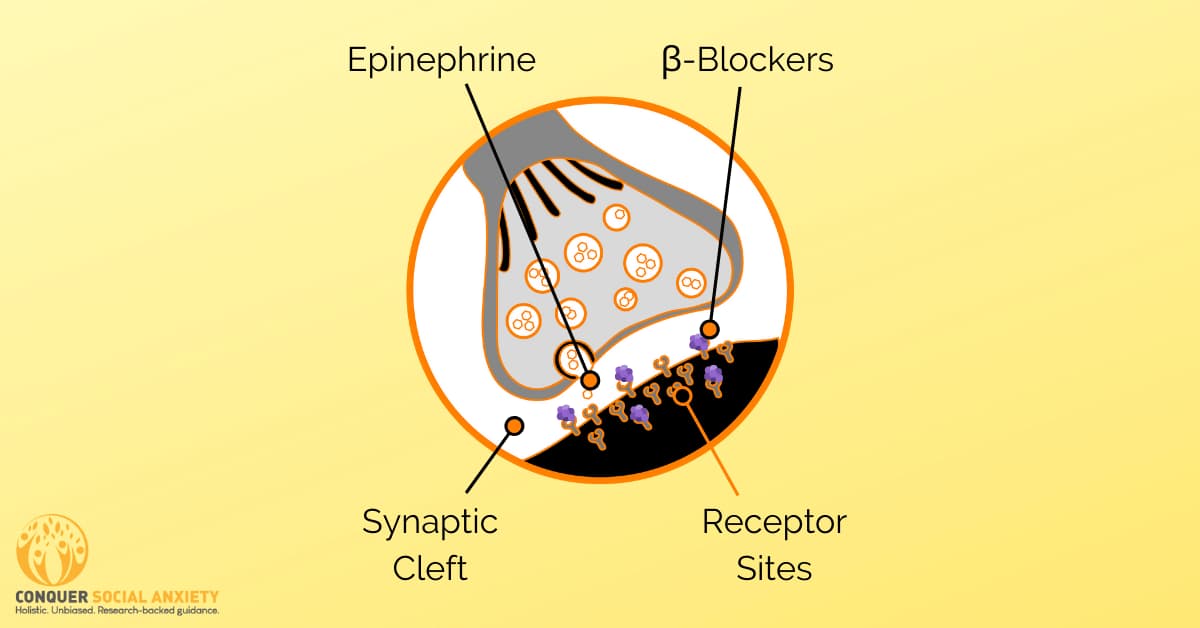
However, it is essential to reiterate that ß-blockers do not directly influence the emotional or cognitive aspects of anxiety, distinguishing them from traditional anxiety medications.
By the way, you can click here to explore our comprehensive article for a deep understanding of all medication options available to manage social anxiety.
Reducing Physical Symptoms of Anxiety with ß-Blockers
The physical symptoms of social anxiety can be particularly distressing and contribute to a cycle of heightened anxiety during social interactions.
ß-blockers act as anxiety “fear flushers,” quelling the physical response to stressors and promoting a calmer physiological state.

Key physical symptoms ß-blockers can help manage include:
- Rapid Heart Rate: ß-blockers slow down the heart rate, preventing it from racing uncontrollably in anxiety-provoking situations.
- Trembling and Shaking: By blocking adrenaline’s effect, ß-blockers can reduce the trembling and shaking often experienced during social anxiety.
- Sweating: To some degree, ß-blockers may also decrease excessive sweating, a common physical response to anxiety.
The ability of ß-blockers to specifically target these physical symptoms makes them particularly valuable for individuals who primarily experience social anxiety’s physical manifestations.
If that’s you, you may also want to click here to read our article on how to handle physical manifestations of social anxiety.
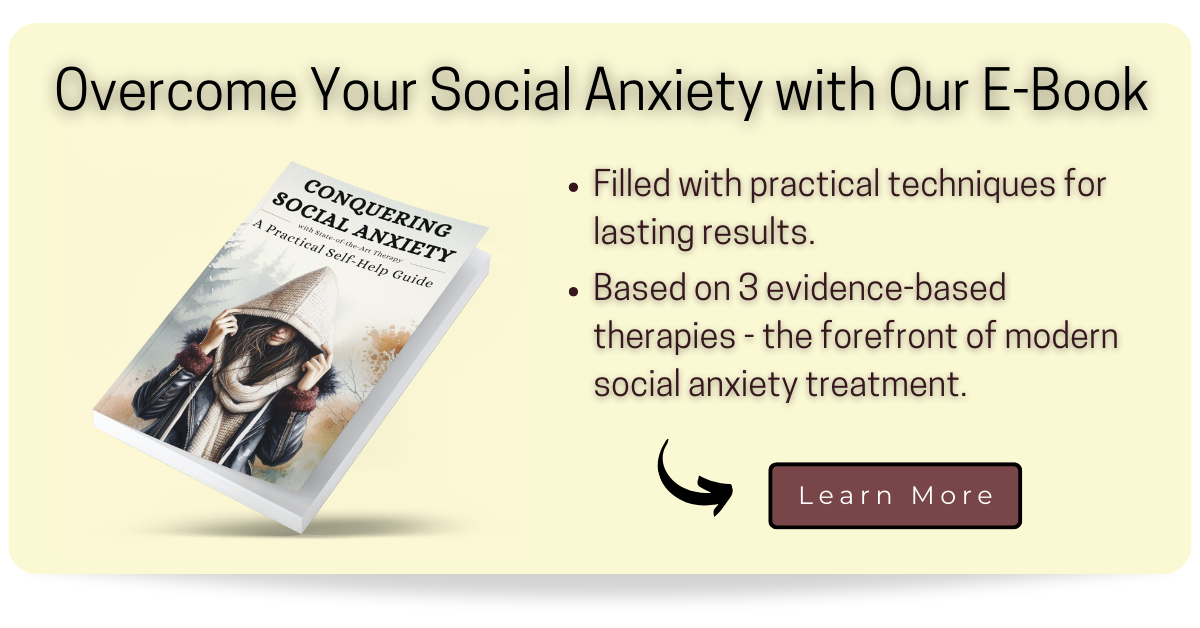
Non-Sedative Nature and Suitability for Specific Situations
One significant advantage of ß-blockers is their non-sedative nature. Unlike some anxiety medications that can cause drowsiness or impair cognitive functioning, ß-blockers typically do not induce sedation.
This characteristic makes them well-suited for situations where mental alertness and performance are crucial, such as public speaking, job interviews, or important social events.

Furthermore, ß-blockers are generally used on an as-needed basis (Bruce & Saeed, 1999).
This means they can be taken specifically before anxiety-provoking events, providing targeted relief during challenging social situations without the need for continuous daily use.
As we move forward, we will explore the effectiveness of ß-blockers in managing social anxiety symptoms, along with potential considerations and precautions when using them as part of a comprehensive anxiety management approach.
C. Effectiveness of ß-Blockers for Social Anxiety
Research and Studies Supporting the Use of ß-Blockers for Social Anxiety
The efficacy of ß-blockers in managing the physical symptoms of social anxiety has been a subject of research and clinical investigation.
Numerous studies have explored the benefits of using ß-blockers in anxiety-provoking situations, particularly those involving public speaking or performance-related tasks (Laverdure & Boulenger, 1991).

Research has consistently demonstrated that ß-blockers can effectively reduce heart rate and trembling associated with social anxiety (e.g., meta-analysis by Kjekshus, 1986).
These studies indicate that ß-blockers may provide significant relief to individuals facing challenging social scenarios, allowing them to navigate these situations with greater composure and confidence.
Success Rates and Efficacy of ß-Blockers in Managing Social Anxiety Symptoms
ß-blockers have shown notable success rates in managing the physical symptoms of social anxiety.
By mitigating the physiological stress response, individuals often report feeling more in control and less overwhelmed during social interactions.
This can lead to improved performance and a reduction in the fear associated with future social situations.

Again, it’s important to highlight that ß-blockers do not directly alter thought patterns or emotional reactions, so their effectiveness may be more pronounced in addressing the physical manifestations of anxiety rather than the underlying psychological aspects.
As such, they are often viewed as a complementary approach to other anxiety management techniques, such as therapy and cognitive-behavioral interventions.
To get a complete overview of all treatment options for social anxiety disorder, we recommend you click here to read our most-read article which provides you with a clear roadmap to getting better.
Addressing Individual Differences in Response to ß-Blockers
As with any medication, individual responses to ß-blockers can vary. While many individuals experience significant relief from social anxiety’s physical symptoms, others may have a more modest response.

Factors that may influence the effectiveness of ß-blockers include:
- Dosage and Timing: The appropriate dosage and timing of ß-blockers can vary depending on the specific anxiety-inducing situation. 10-40mg are typically taken 30 minutes to an hour before stressful social events, allowing the medication to take effect and provide relief from anxiety’s physical symptoms. Working closely with a healthcare professional can ensure that the right dose is administered at the most effective time.
- Personal Physiology: Individual variations in how the body responds to medications can influence the impact of ß-blockers. Some people may find ß-blockers extremely effective, while others may experience milder effects.
- Combination with Other Treatments: Combining ß-blockers with therapy or other anxiety management strategies can enhance overall outcomes. Integrating various approaches tailored to individual needs is often the most effective approach to managing social anxiety.
- Psychological Aspects: As mentioned earlier, ß-blockers address the physical symptoms of anxiety but do not directly target psychological aspects. Therefore, individuals who primarily struggle with emotional or cognitive aspects of social anxiety may benefit from additional psychological support.

Understanding that responses to ß-blockers can vary is essential, and it underscores the importance of personalized treatment plans and ongoing communication with a healthcare provider.
In the following sections, we will explore the advantages and limitations of ß-blockers for social anxiety, providing a well-rounded understanding of their potential role in an individual’s anxiety management journey.

D. Pros and Cons of ß-Blockers for Social Anxiety
Advantages of Using ß-Blockers for Specific Social Anxiety Situations
- Targeted Symptom Relief: ß-blockers excel at reducing the physical symptoms of social anxiety, such as rapid heart rate, trembling, and sweating. This targeted relief can help individuals feel more at ease and focused during anxiety-provoking situations.
- Performance Enhancement: For scenarios like public speaking, job interviews, or important social events, ß-blockers can be particularly beneficial. By curbing physical anxiety symptoms, individuals may perform better and feel more confident in such high-pressure situations.
- Non-Sedative Nature: Unlike some anxiety medications, ß-blockers do not cause drowsiness or impair cognitive function. This non-sedative quality allows individuals to remain mentally alert and engaged while managing social anxiety’s physical effects.
- As-Needed Usage: ß-blockers are typically taken on an as-needed basis, making them suitable for selective use during specific social situations that provoke anxiety. This flexibility allows individuals to tailor their usage based on their unique needs.

Potential Side Effects and Safety Considerations
- Low Blood Pressure: ß-blockers can lower blood pressure, which may be problematic for individuals with pre-existing low blood pressure or certain medical conditions. Monitoring blood pressure regularly is essential, especially when starting a new medication.
- Fatigue and Dizziness: While ß-blockers are generally non-sedative, some individuals may experience mild fatigue or dizziness. These side effects are usually temporary and diminish as the body adjusts to the medication.
- Respiratory Issues: People with asthma or other respiratory conditions should use ß-blockers cautiously, as they can potentially worsen breathing problems. Proper medical evaluation is crucial before starting ß-blocker treatment.
- Masking of Anxiety Cues: Since ß-blockers target physical anxiety symptoms, they may mask early warning signs of anxiety. Individuals should still pay attention to their emotional and cognitive reactions to effectively manage social anxiety.

Scenarios Where ß-Blockers May Not Be the Ideal Choice for Treatment
- Emphasis on Emotional Coping: For individuals seeking comprehensive treatment that addresses emotional and cognitive aspects of social anxiety, ß-blockers may not fully align with their needs. Therapeutic interventions and counseling should certainly be the priority in such cases.
- Underlying Medical Conditions: Certain medical conditions may contraindicate the use of ß-blockers. It is crucial for healthcare providers to conduct a thorough evaluation and review medical history before prescribing ß-blockers for social anxiety.
- Primary Psychological Distress: Individuals who primarily experience emotional distress or cognitive challenges with social anxiety may require treatment approaches that directly target these aspects. ß-blockers do not address these components of anxiety.
- Comprehensive Treatment Approach: ß-blockers are most effective when used as part of a comprehensive anxiety management plan that includes therapy, lifestyle adjustments, and coping strategies. Relying solely on ß-blockers may limit the overall effectiveness of treatment.

In the next sections, we will provide guidance on how to use ß-blockers for social anxiety, discuss the benefits of combining them with other therapies, and address important precautions and considerations.
E. How to Use ß-Blockers for Social Anxiety
Importance of Consulting a Healthcare Professional Before Starting Any Medication
Before considering ß-blockers or any medication for social anxiety, it is crucial to consult a qualified healthcare professional, such as a psychiatrist or a mental health specialist.
They will conduct a thorough assessment of your symptoms, medical history, and individual needs to determine if ß-blockers are a suitable option.
A healthcare professional can also discuss potential risks, benefits, and any interactions with other medications you may be taking.
This personalized evaluation ensures that ß-blockers are prescribed safely and effectively as part of your anxiety management plan.

You can conveniently schedule an online appointment with a qualified psychiatrist, licensed in your state, through our following partner-link, which gives you an $80 discount.
The psychiatrists from Talkspace can provide a comprehensive evaluation, offer a diagnosis if applicable, and prescribe medication, such as beta-blockers, if deemed appropriate for your specific needs.
Your prescription will be sent to a local pharmacy of your choice. Every three months you’ll have a follow-up video appointment, and you can message your provider any time.
Prescription treatment with Talkspace costs you about $30/month if you are insured, and about $60-$100/month when you pay out-of-pocket. Remember, through our link you will get a special coupon code.

Typical Dosage and Usage of ß-Blockers for Social Anxiety
ß-blockers are typically taken as needed, shortly before anxiety-inducing events.
The dosage may vary depending on individual factors such as age, weight, and overall health. Typical dosages for performance anxiety typically fall within the range of 10 to 40 mg.
Healthcare professionals may recommend starting with a low dose and adjusting it based on your response and the specific situation.

It is essential to follow the prescribed dosage and usage instructions provided by your healthcare provider.
Avoid changing the dosage or frequency without consulting them first, as doing so may affect the medication’s effectiveness or lead to unwanted side effects.
Practical Tips for Managing Anxiety in Social Situations While on ß-Blockers
While ß-blockers can provide relief from physical anxiety symptoms, combining them with practical coping strategies can further enhance their effectiveness.
Here are some tips to help you manage social anxiety in real-life situations while using ß-blockers:
- Breathing Exercises: Practice deep breathing techniques to calm your body and mind before and during anxiety-provoking events.
- Positive Visualization: Visualize yourself succeeding and feeling confident in social situations. This can help build a positive mindset and reduce anxiety.
- Gradual Exposure: Gradually expose yourself to social situations that trigger anxiety. Start with less challenging scenarios and work your way up to more anxiety-provoking events.
- Focus on the Present: Stay present in the moment and avoid getting caught up in negative thoughts about past experiences or worrying about future outcomes.
- Practice Relaxation Techniques: Engage in activities that promote relaxation, such as yoga, meditation, or spending time in nature.
- Mindfulness: Practice mindfulness to increase self-awareness and reduce the impact of anxious thoughts and feelings.
For more practical steps to improve your social anxiety, we recommend clicking here to explore our compilation of 20 tips and exercises. Each one is accompanied by a downloadable PDF, making it easy to implement these strategies into your daily life.

Remember, ß-blockers are not a stand-alone solution but a valuable tool in managing social anxiety’s physical symptoms.
Incorporating these practical strategies alongside medication can lead to more comprehensive and lasting results in your anxiety management journey.
In the next sections, we will explore the benefits of combining ß-blockers with therapy and other treatment approaches, address important precautions, and discuss scenarios where ß-blockers may not be the ideal choice.
F. Combining ß-Blockers with Other Therapies
Benefits of Using ß-Blockers Alongside Therapy or Other Treatment Approaches
Combining ß-blockers with therapy or other evidence-based treatments can create a powerful synergy in managing social anxiety.
By targeting the physical symptoms, ß-blockers can provide a supportive foundation for individuals to engage more effectively in therapeutic interventions.

Some of the key benefits of this combination include:
- Enhanced Treatment Outcomes: Addressing both the physical and psychological aspects of social anxiety can lead to more comprehensive and favorable treatment outcomes.
- Increased Treatment Engagement: ß-blockers can help individuals feel more at ease and comfortable during therapy sessions, allowing them to actively participate and gain more from the therapeutic process.
- Reduced Avoidance Behaviors: By lessening the physical distress associated with social anxiety, individuals may be more inclined to face anxiety-provoking situations, gradually reducing avoidance behaviors.

Strategies for Maximizing the Effectiveness of ß-Blockers in Conjunction with Other Treatments
To maximize the benefits of combining ß-blockers with other therapies, consider the following strategies:
- Open Communication: Maintain open and honest communication with both your healthcare provider prescribing ß-blockers and your mental health professional. Share your experiences and any changes in symptoms or anxiety triggers.
- Personalized Treatment Plans: Work with your healthcare team to create a personalized treatment plan that addresses your unique needs and preferences. This may include a combination of therapy, medication, and coping strategies.
- Practice Coping Skills: Continue practicing coping skills learned in therapy, even when using ß-blockers. The integration of coping strategies can reinforce positive behavioral changes.
- Identify Trigger Situations: Collaborate with your healthcare provider and mental health professional to identify specific social situations that provoke anxiety. Tailoring ß-blocker usage to these scenarios can be especially beneficial.
- Set Realistic Goals: Establish realistic goals for your anxiety management journey and celebrate each step of progress. Gradual improvement is valuable and can lead to significant long-term change.

Addressing Potential Interactions with Other Medications and Importance of Communication with Healthcare Providers
Inform your healthcare provider about all medications you are taking, including over-the-counter drugs and supplements.
Some medications may interact with ß-blockers and affect their effectiveness or lead to adverse reactions. Common interactions include those with blood pressure medications and certain antihistamines.
Additionally, be proactive in discussing any changes in your health status or concerns with your healthcare provider.
Regular check-ins and follow-up appointments are essential to ensure the medication’s ongoing suitability and effectiveness.

In the final sections, we will outline essential precautions and considerations for using ß-blockers, address specific populations, and offer concluding remarks.

G. Precautions and Considerations
Addressing Specific Populations
- Pregnant Women: Pregnant individuals should exercise caution when considering ß-blockers for social anxiety. Some ß-blockers may pose risks to fetal development, so it is essential to discuss potential alternatives with a healthcare provider.
- Individuals with Medical Conditions: Certain medical conditions, such as heart conditions, asthma, diabetes, or circulation disorders, may require careful evaluation before starting ß-blocker treatment. Inform your healthcare provider about any existing medical conditions to ensure safe usage.
Importance of Adhering to Prescribed Dosages and Avoiding Abrupt Discontinuation
Adhering to the prescribed dosage of ß-blockers is crucial for their effectiveness and safety.
If you have concerns about your medication or experience any adverse effects, consult your healthcare provider before making any changes to your dosage or medication regimen.

Regular Check-ins with Healthcare Providers
Regular check-ins with healthcare providers are essential for monitoring progress and addressing any concerns related to ß-blocker usage.
They can assess your response to the medication, make dosage adjustments if necessary, and ensure that ß-blockers remain a suitable part of your anxiety management plan.
Open communication with your healthcare provider allows for adjustments as your social anxiety management needs evolve over time.
Whether it’s addressing side effects, optimizing dosage, or exploring alternative treatment options, your healthcare provider can provide valuable guidance and support throughout your journey.

In the final section, we will offer concluding remarks and reinforce the importance of seeking comprehensive support in managing social anxiety.
H. Conclusion
In the quest to overcome the challenges of social anxiety, ß-blockers stand as a valuable ally in managing the physical symptoms that often accompany this condition.
By targeting the body’s stress response, ß-blockers can effectively reduce rapid heart rate, trembling, and sweating, providing individuals with a sense of control and composure during nerve-wracking social situations.
ß-blockers offer unique advantages, including their non-sedative nature, as-needed usage, and suitability for performance-related events.

When used in conjunction with other treatment approaches, they can enhance overall treatment outcomes and help individuals engage more effectively in therapeutic interventions.
For those grappling with social anxiety, seeking professional help is a crucial step in reclaiming one’s life and well-being.
Consulting a qualified healthcare provider, mental health specialist, or psychologist can open doors to a range of treatment options tailored to individual needs.
Therapy, coping strategies, and lifestyle adjustments can all play pivotal roles in managing social anxiety. ß-blockers, as a targeted medication option, can complement these strategies, specifically addressing the physical symptoms that contribute to the distress of social anxiety.

You have the power to shape your social anxiety narrative, and with appropriate treatment and support, you can embark on a path toward a brighter, more empowered future.
Together, we stand as a community of hope and encouragement, fostering an environment where compassion, understanding, and resilience pave the way to overcoming social anxiety’s challenges.
Join our community today by taking our free 7-day E-mail Course, which teaches you everything you need to know if you suffer from social anxiety.
By the way, another substance that has garnered significant research attention in recent years is CBD. Notably effective in reducing social anxiety without causing sedation, CBD offers promising benefits.
To delve into the topic, we invite you to click here to read our comprehensive article on CBD for social anxiety.
Participate in a Research Study!
If you are affected by social anxiety, you can help researchers and clinicians better understand the condition and improve treatment efficacy by participating in a research study.
To take part, you can click here to open a short, quick survey in a new browser window, or simply fill out the form provided below. Thank you for your participation!
Bruce, T. J., & Saeed, S. A. (1999). Social anxiety disorder: a common, underrecognized mental disorder. American family physician, 60(8), 2311–2322.
Kelly, D.H. (1980). Clinical review of beta-blockers in anxiety. Pharmakopsychiatrie, Neuro-Psychopharmakologie, 13 5, 259-66 .
Kjekshus J. K. (1986). Importance of heart rate in determining beta-blocker efficacy in acute and long-term acute myocardial infarction intervention trials. The American journal of cardiology, 57(12), 43F–49F. https://doi.org/10.1016/0002-9149(86)90888-x
Lader M. (1988). Beta-adrenoceptor antagonists in neuropsychiatry: an update. The Journal of clinical psychiatry, 49(6), 213–223.
Laverdure, B., & Boulenger, J. P. (1991). Médications bêta-bloquantes et anxiété. Un intérêt thérapeutique certain [Beta-blocking drugs and anxiety. A proven therapeutic value]. L’Encephale, 17(5), 481–492.
Tyrer P. (1988). Current status of beta-blocking drugs in the treatment of anxiety disorders. Drugs, 36(6), 773–783. https://doi.org/10.2165/00003495-198836060-00006
Williams, T., Hattingh, C. J., Kariuki, C. M., Tromp, S. A., van Balkom, A. J., Ipser, J. C., & Stein, D. J. (2017). Pharmacotherapy for social anxiety disorder (SAnD). The Cochrane database of systematic reviews, 10(10), CD001206. https://doi.org/10.1002/14651858.CD001206.pub3

About the Author: Martin Stork
Martin is a professional psychologist with a background in physical therapy. He has organized and led various support groups for people with social anxiety in Washington, DC and Buenos Aires, Argentina. He is the founder of Conquer Social Anxiety Ltd, where he operates as a writer, therapist and director. You can click here to find out more about Martin.








